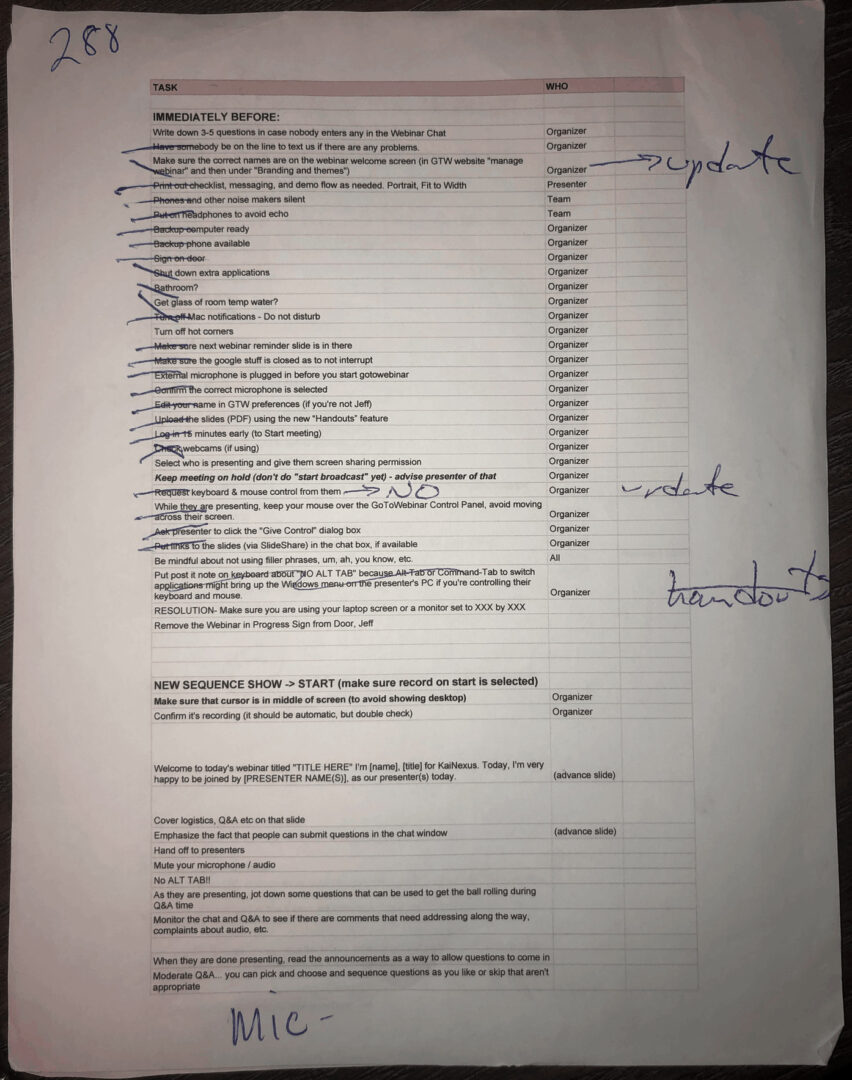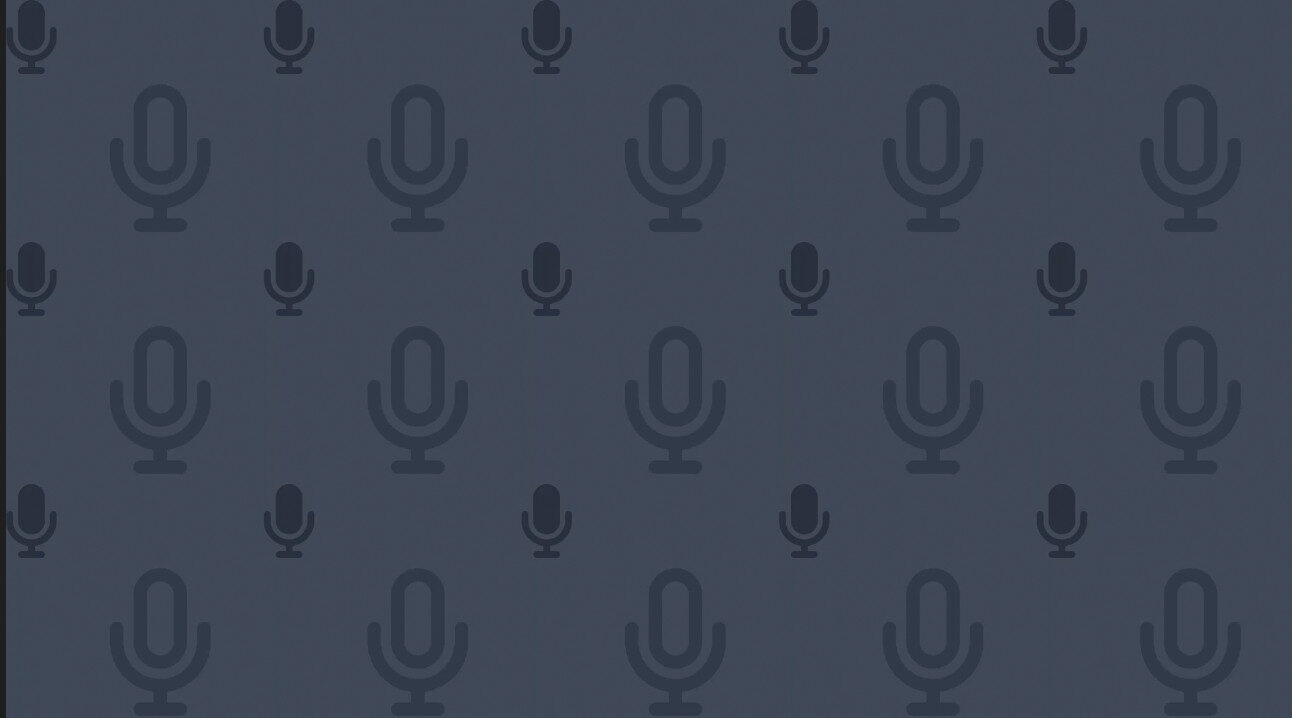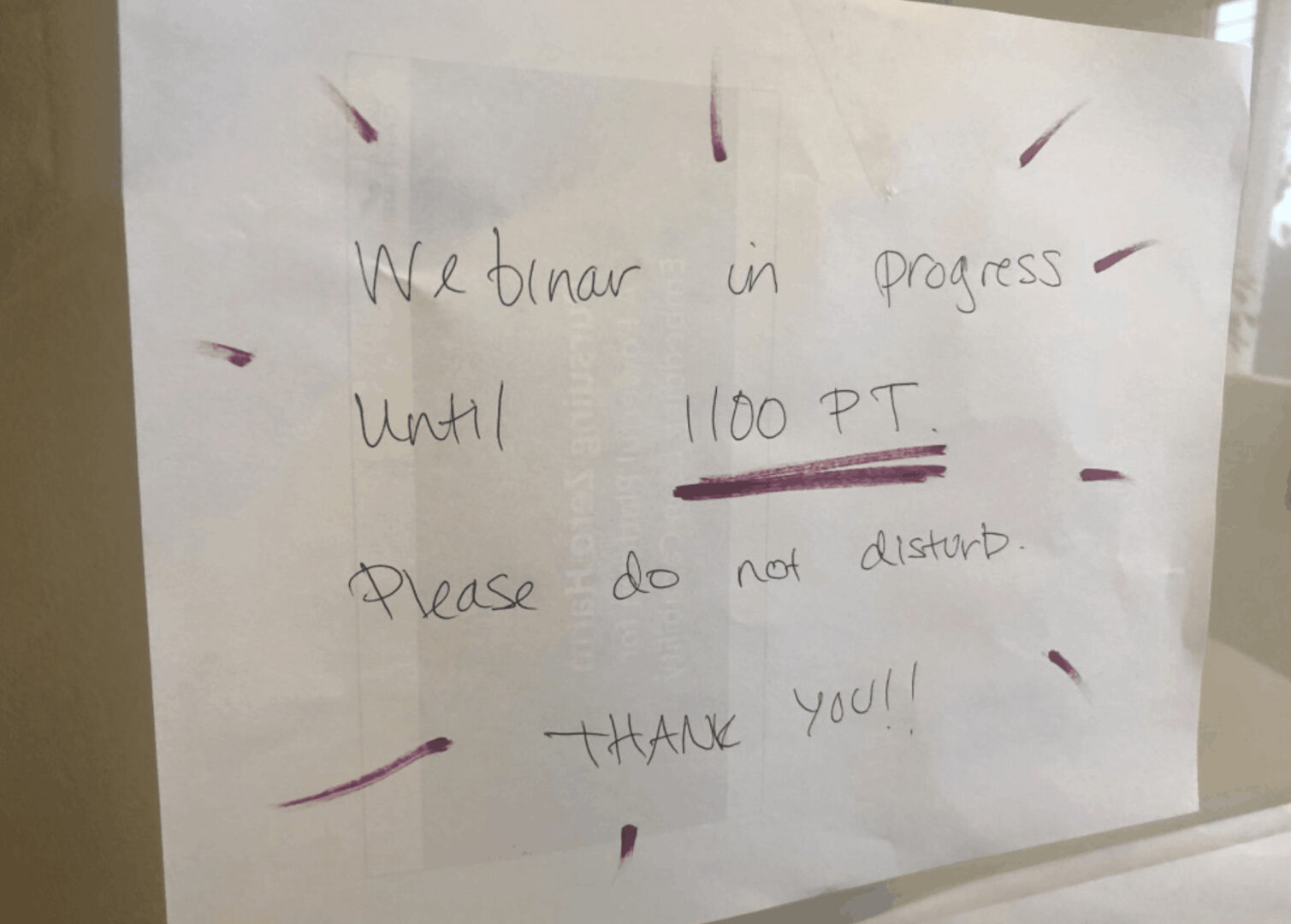For years, Dr. Greg Jacobson and I have used checklists when prepping for and running our various webinars via KaiNexus. You can join us today for a webinar that's being presented by Barry O'Reilly: “Why Great Leaders Must Unlearn to Succeed in Today's Exponential World.” I hope you can join us. I'll be there with my checklist.
We originally had one checklist that included advance planning, day-of prep and execution, and follow up.
As with any healthy and helpful checklist approach, the checklist is ever evolved based on changing circumstances and my near-constant discoveries of new ways to demonstrate human fallibility.
Too many organizations struggle or fail when a checklist is created as a one-time exercise. It's worse when the checklist isn't created by those who do the work (such as when a hospital buys a pre-surgical checklists from a consultant). In comparison, Greg and I (and others on our team have created and modified the checklist over time).
Having a checklist isn't enough. What matters more is using it and improving it over time. In a setting like an airplane cockpit or an operating room, you need to also have a culture that makes it safe for anybody to speak up if they have a concern. At Toyota, that “speaking up” often takes place in the form of a team member “pulling the andon cord,” as they say.
Sometimes, I use the checklist on screen, viewing it in Google Docs. Other times, I print it out and use it like this:

When I'm being good — when I'm being disciplined — I literally check off each thing on the checklist. Some of the items are reminders that Greg put on there for himself and they don't apply to me.
I also mark down updates and revisions that should be made to the checklist, including:
- Items to take off because they're no longer relevant
- Items to revise or edit for some reason
- Items to add because of some new failure mode that was anticipated (or experienced)
One other change that we've made is to separate this out into two checklists.
One is the “advanced planning and follow up” (before and after) checklist that's mainly used by me and our director of marketing, Maggie Millard.
This led to a simpler “day of” checklist. That way, if somebody else is hosting the webinar, they have a more focused and targeted checklist that has just what matters to them. It's important to keep the checklist from being overwhelming because it's too long, due to irrelevant items.
We also have a checklist that we share with our remote webinar presenters.
Checklists Only Work When You Use Them
Back in December, I presented a webinar on Process Behavior Chart case studies and Greg played the role of host. Normally, I'm the host and I focus my mental prep and energy on the checklist and the presenter is thinking about content.
I was thinking about content AND logistics. I got sloppy and didn't use the checklist. This burned me.
I forgot to upload a PDF of my slides as a handout in GoToWebinar. This was hardly a fatal error, unlike it might be for a pilot or a surgeon, but I still felt bad. A good process only helps when you follow the good process.
I fell into the trap of thinking, “I've done a ton of
In the past, I've found the checklist to be particularly helpful when you're under stress — when the internet or wi-fi goes down just before the webinar or when the presenter is late because of time zone confusion. During some mad scramble, it's easier to forget things and the checklist is more helpful.
Checklists Only Work When You REALLY Use Them
Last week, I was again in the host role for a webinar presented by Meghan Scanlon of Value Capture. Normally, the presenter is at another computer in another location. This time, Meghan and I happened to be sitting side by side because we were both at a Value Capture “team learning” event. This difference in the process and circumstances has some meaning… read on.
Over time, we've changed the standardized work to have the webinar presenter share their screen to run the slides from their end. In the past, I would have the presenter run the slides from my screen by giving them remote access. But, there were sometimes lags and delays in advancing the slides. The presenter would click next and then thought nothing happened (due to the delay) so they clicked again… oops then it advanced, meaning they had to back up. It just sometimes caused unnecessary confusion.
So, the change was made to have the presenter share their screen. That's a good countermeasure for that typical circumstance.
This time, Meghan and I were in front of the same laptop. I had GoToWebinar running on it and before the start of the webinar I put the PowerPoint slides into presentation mode.
I was quite proud of myself for running through all of the prep items on the checklist by 9:45 am PT… 15 minutes before starting the webinar. Mistakes happen when you're pressed for time. It's good to avoid that stress.
Meghan was sitting next to me and I was talking to her about the content… reinforcing that I thought she was going to do a great job… trying to help her get pumped up for the webinar.
I was watching the clock and I hit “START” in the GoToWebinar control panel at the top of the hour.
GoToWebinar added a feature two years ago (or so) that's helpful error proofing. It's now set to automatically start recording when you start the webinar if you check the “record on start” checkbox.
In older versions of GoToWebinar, if you hit “show screen,” it would automatically start the webinar. Therefore, our old checklist sequence for launching a webinar was START, SHOW, RECORD. It could have been
With the autorecord, and other changes that now allow you to show your screen without starting the webinar, the new checklist sequence was supposed to be this:

But, I started the webinar without referring to the checklist. My bad.
All I did was hit START. I gave the intro, covered logistics, introduced Meghan, and handed things over to her.
Then the “Andon Cord” Got Pulled
Four minutes in, I noticed a text message from Matt Banna at KaiNexus. He was watching the webinar live.

Thankfully, he spoke up. And he was nice about it. He knew there were supposed to be slides… there's always slides… Basically, he was “pulling the andon cord” — he was speaking up and pointing out a potential problem.
The audience was only seeing this instead of slides:

I was able to make a quick adjustment. I had to interrupt Meghan… but I jumped in and hit “show screen.” One problem was fixed. But, since I didn't click back on PowerPoint, she had trouble adjusting the slides.
I edited the problems of the video recording and overlaid the missing slides as images. But, I published unedited audio in the podcast recording, especially since I spoke about the error and apologized before we started Q&A after her presentation.
All I can do is commit to being more disciplined about using the checklist… really using the checklist in the fullest sense. Again, I apologize to Meghan for that distraction, but she handled it like a pro.
When the Checklist DID Help us Last Week
This is an addition to the original post. I forgot about one thing that helped.
The checklist has an item about putting a sign on the door that says, “Webinar in progress: do not disturb.” That an intended for a presenter or host in the Austin office of KaiNexus. I don't do this when I'm at home.
When Meghan and I were prepping, we were presenting from a conference room that had been reserved for us at a health system. I almost skipped the sign on the door, but thought, “If we don't put it up, then we'll get burned.”
Meghan made and hung this sign:

Sure enough, halfway through the webinar, I noticed a woman who was approaching the door and was about to knock. But, she saw the sign and didn't do that. Warning signs aren't always effective… but sometimes they are — or they are the best you can do in the circumstances to prevent a problem.
I hope there are some helpful lessons in this for you and your work.
What do you think? Please scroll down (or click) to post a comment. Or please share the post with your thoughts on LinkedIn – and follow me or connect with me there.
Did you like this post? Make sure you don't miss a post or podcast — Subscribe to get notified about posts via email daily or weekly.
Check out my latest book, The Mistakes That Make Us: Cultivating a Culture of Learning and Innovation:









